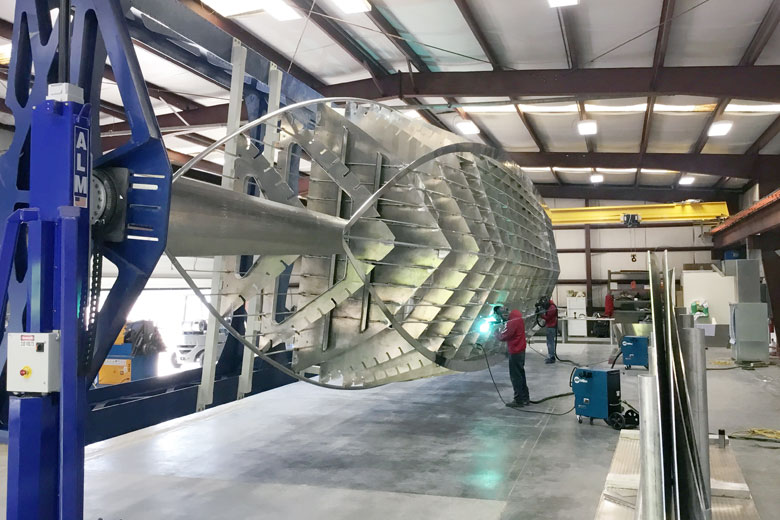Doubling down on quality in half the time: Boat building with Chesapeake Yachts
When Colten Brunenn, Product Manager and Engineer at ALM Positioners, got a call from a prospective customer about wanting to build boat hulls using a positioner, the ALM team sprang into action.
What Brunenn didn’t know, though, was that the boats that Jack Stephens, owner of Chesapeake Yachts, was calling about were much larger projects than anticipated.
The specs of the project were 75 feet by 14.5 feet, with less than 3/4-inch deflection over the entire length. ALM Positioners spent about one month on the design and built a 35,000-pound extended vertical travel positioner that has 416,000-inch-pounds of rotational torque with six feet of travel on the tailstock for adjustability.
The result of the month-long project was a movable tailstock that allowed Stephens to change the length from boat to boat or move the headstock and tailstock to different elevations to adjust the horizontal alignment.
ALM Positioners visited Stephens in Chesapeake, Virginia, for a glimpse into Chesapeake Yachts’ positioner usage.
Before using the positioner, how did you assemble the frame for the boat?
We built the frame inverted on the shop floor, climbing in and out to do the welding, sliding under the frame on a creeper.
Had you visited your competitors? How do they fabricate their frames?
Yes, they do it the same way we used to. Climbing in and out frequently on their backs on a creeper. This boat, using the positioner, is about 3,000 man-hours to complete. The first boat we built like this on the ground took 6,000 man-hours.
What are your overall thoughts on the positioner?
The positioner has been really good. It’s been surprising to me how much better it has made everything, in terms of weld quality. The guys work so much better than they did. They were so tired and ready to quit at three o’clock in the afternoon. Now, we’ve been here until five and six o’clock and don’t realize what time it is.
If the boat is 64 feet by 16 feet wide and is about 20,0000 pounds on top of the cradle, the cradle itself weighs about 13,800 pounds. The deflection of the center on the cradle is about 15/16 with no load on the cradle. Once the boat is framed, it isn’t going anywhere until the deflection goes away. When we put the cradle beams together, we lasered the beams and one end was out only ten thousandths. At 70 feet, that wasn’t too bad. The engineering was done correctly, that’s for sure.
Any other added benefits of using the positioner?
The best testimonial to the weld quality was that it passed the Coast Guard inspection with flying colors. Overall, inspections are much easier. With the ability to rotate the boat directly to the ground, they do not have to climb inside with flashlights to do the inspections. The Coast Guard loves coming over here. A few weeks ago, they brought some cadets from the Coast Guard Academy engineering group to view the construction and they were definitely impressed.
Watch the interview with Jack Stephens here.
Download a PDF version of this product story


